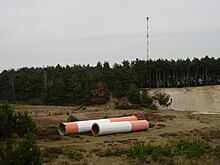Verden transmitter
|
Verden transmitter
|
||
|---|---|---|
| Basic data | ||
| Place: | Kirchlinteln | |
| Country: | Lower Saxony | |
| Country: | Germany | |
| Altitude : | 39 m above sea level NN | |
| Coordinates: 52 ° 54 ′ 34.4 " N , 9 ° 18 ′ 22" E | ||
| Use: | Telecommunication system | |
| Owner : | German radio tower | |
| Mast data | ||
| Construction time : | 1966 | |
| Operating time: | since 1966 | |
| Total height : | 202 m | |
| Data on the transmission system | ||
| Last modification (transmitter) : | 2013 | |
| Send types: | Cellular radio , directional radio | |
| Position map | ||
|
|
||
The Verden transmitter is a broadcasting facility for television that was built as a lattice mast by the former Deutsche Bundespost in 1966.
location
Contrary to the name, the location is not in the area of the town of Verden (Aller) , but in the area of the municipality of Kirchlinteln , more precisely on the border between the localities of Luttum and Weitzmühlen. Geographically, the facility is located on two pieces of land: the transmitter mast, the company buildings including access roads and the east / north-west guy facilities are in the area of the municipality of Kirchlinteln, the south-west guy facilities are in the area of the city of Verden. The location of the tower is located on a ridge and is 39 m above sea level. NN is one of the highest peaks in the area.
use
Since the introduction of digital terrestrial television and the associated discontinuation of analogue terrestrial television, television broadcasting has been discontinued at the Verden transmitter, as it was not converted for the transmission of digital television.
At the end of 2007 the television antenna and the GRP cylinder surrounding it were dismantled. The transmitter lost 20 meters from its original height of 222 meters.
Since TV broadcasting was discontinued, the lattice mast has only been used as a carrier for cell phone antennas.
Since the end of 2010, a regional Internet service provider has been supplying some surrounding towns with high-speed Internet. The DSL technology in these localities is connected to the Internet via the radio relay systems installed on the radio tower. The directional radio systems were continuously expanded to meet the increasing demand for bandwidth. Many localities have been connected by fiber optic since 2016. The directional radio links have been maintained as a backup since then and are used to compensate for peak loads.
In 2012, LTE transmission antennas and corresponding radio relay systems were installed on the radio tower to feed two mobile network operators. Additional radio relay systems were also installed to supply other surrounding villages. In 2019, the mobile operators T-Mobile and Vodafone made extensive expansions to expand the LTE network.
history
The "radio tower", as it is also called in the area, has become a kind of landmark and is an excellent landmark.
After the transmitter was built towards the end of the 1960s, it broadcast television images using analog technology. Using the techniques of C-Netz , Eurosignal , D-Netz-Mobilfunk up to the transmission of internet traffic, this location has followed the era of digitization and has now returned to its edifice: It transmits television (TV), albeit now via the Internet as a live stream.
In contrast to similar towers, little information was published about the Verden transmitter.
Air accident in 1971
On May 13, 1971, a Dutch "Norfolk F5" fighter jet (presumably a Northrop F-5 fighter aircraft ) was on a training flight from / to Twente when the pilot apparently overlooked the transmitter mast and his guys while flying low . The jet crashed into one of the guys, tearing off a wing and spinning the plane out of control. The pilot tried to save himself with the ejector seat, but was catapulted into the attic of a barn in the neighboring village of Luttum and died there. The machine itself also crashed in Luttum, in a residential building. A major fire developed due to the leaking and immediately igniting kerosene. However, apart from the pilot, there were no other casualties to complain about.
Contribution to nature conservation
There is a peregrine falcon nesting box on the 60 meter platform . This was built by the peregrine falcon protection North Germany eV with the permission of the owner in the early 1990s. Successful broods take place there at regular intervals. In 2018, the nesting box was moved from a location below the 60-meter platform to the 60-meter platform.
owner
The operator and owner of the system is Deutsche Funkturm GmbH (DFMG) based in Münster , a subsidiary of Deutsche Telekom AG .
Former frequencies and programs
Analog television (PAL)
The broadcast of analog television in PAL was discontinued with the introduction of DVB-T . This means that there are no more radio transmissions from this location.
| channel |
Frequency (MHz) |
program |
ERP (kW) |
Antenna pattern round (ND) / directional (D) |
Polarization horizontal (H) / vertical (V) |
|---|---|---|---|---|---|
| 25th | 503.25 | ZDF | 66 | D (100 °) | H |
| 60 | 783.25 | NDR television (Lower Saxony) | 58 | D (100 °) | H |
Web links
- Transmission mast Kirchlinteln. In: Structurae
- Official website of the Deutsche Funkturm GmbH
- Website of the Wanderfalken-Schutz Norddeutschland eV with background information on breeding grounds on radio towers
Individual evidence
- ^ "From the Turnerkreis to the modern fire brigade - 125 years of the Verden volunteer fire brigade" (Verlag HM Hauschild, Bremen, 1994; p. 59f)




